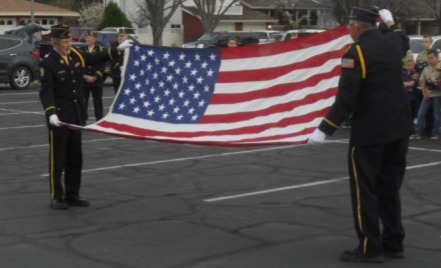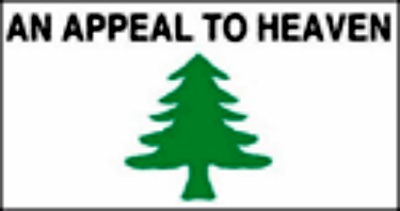
ST. GEORGE — During a ceremony attended by more than 160 hushed onlookers in March, over four dozen American flags were properly retired by the American Legion Post 90 of St. George.

During the ceremony, the most recognizable symbol of the United States – 50 of them in fact – were placed on a burn pyre during a time-honored ceremony that has been performed by various groups throughout the country since 1942.
The involved fifty uniformed Boy Scouts from Troop 1765, who stood in a single line formation, each holding an American Flag to be properly retired during the ceremony officiated by Foster Johnson, Commander of the Post 90 Ritual Team.
The ceremony was held in the parking lot of the Church of Jesus Christ of Latter-Day-Saints’ chapel off 900 South and was attended by a crowd of 165, including St. George Mayor Jon Pike and St. George City Council members Ed Baca, Jimmie Hughes and Michele Randall.
“That was by far the largest crowd that we’ve ever had at one of these events, and it was great,” Harvey Hefley of Post 90 told St. George News Thursday.
For many, this was the first flag disposal ceremony ever witnessed, Hefley said, which is the purpose behind the public display that is designed to serve as an educational and memorable experience.
After providing a brief history of the flag and outlining proper handling procedures, the crowd joined in during the Pledge of Allegiance before the flags were presented for disposal.

Then each flag was placed on the burn pyre by ritual team volunteers with American Legion Post 90 and Post 42.
Hefley said that many people believe that burning a flag is unpatriotic, based on situations where the flag is burned in defiance or to desecrate the flag.
The opposite is true, he said, as long as it is done in accordance with regulations for respectfully retiring a flag that has been in service.
Proper disposal is important, he added, as “the worst thing that can happen is for the flag to end up in a trash can.”
According to the federal code, when an American flag is in such condition that it is “no longer a fitting emblem for display,” the flag should be destroyed in a “dignified way, preferably by burning.”
The March ceremony was made possible through American Legion Post 90 of St. George volunteers, eight Boy Scout Troops and area Cub Scout Packs, the National Parks Council, civic leaders, and two LDS church young women’s groups.
Hefley said the American Legion Post 90 performs the service at the request of various organizations under the premise that it is “good for the community to see how a flag is properly disposed of.”
The organization also places 100 American flags at various locations throughout Washington County every year in honor of Flag Day, which takes place June 14.
Flags slated for proper disposal can be dropped off at the American Legion Post 90 office at 245 N. 200 West in St. George.
“Old Glory’s” long and convoluted journey
Nothing may evoke such strong emotion as seeing the American flag, either at a ceremony honoring a great event or when draped over the coffin of a military veteran in honor of their service.

Somewhat surprisingly, the American flag’s official debut has yet to be decided by scholars. Some say the flag reportedly made by Betsy Ross was flown for the first time on Cooches Bridge in Newark, Delaware, during the Revolutionary War in September 1777, but this point is disputed by historians who believe the volunteer infantry that relied on stealth would never have announced their arrival by flying a flag into battle.
Various accounts also have it that the first two American flags were captured by British troops during a surprise attack that same year and sent back to England as trophies.
Even if a flag was flown during that battle, it’s hard to say what that would have looked like, since the American flag flown today is much different than the dozen or more flags flying across the colonies a few hundred years ago.
In fact, the first flag in 1775 was white with a pine tree in the middle with “An Appeal to Heaven” embroidered across the top.

The Continental Navy flew a flag with a snake lying across red and white stripes with the warning “Don’t Tread on Me,” followed by the Sons of Liberty flag with only red and white stripes, until the pine tree made a reappearance toward the end of 1775, followed by a flag that combined the Flag of England atop the red and white stripes that was flown the following year and so on.
That massive confusion was resolved in 1790 when the Continental Congress officially declared the Flag of the United States “to be thirteen stripes, alternate red and white; that the union be thirteen stars, white in a blue field, representing a new constellation.”
However, the flag’s journey was far from over, continuing until 1912 when a presidential order defining the design of the flag – including the star arrangement – was signed. And other than the adding of stars, it has remained unchanged ever since.
The American flag is granted federal protections
Despite dozens of national flags flying around, there were no unified regulations governing the display or handling of any of them in 1775. Getting all of that straightened out would take another 250 years.
In 1923 a “Flag Code” was adopted at a conference attended by the Army, Navy and 65 other national groups that all had their own flag-handling procedures until the code passed through Congress and was signed into law in 1942.
The code does not impose any penalties, though, thanks to a 1990 Supreme Court ruling that said to do so would infringe upon the First Amendment, which “prohibits any law limiting freedom with respect to religion, expression, peaceful assembly, or the right of citizens to petition the government.”
Despite the many changes, codes, rulings and designs, for many, the American flag has become the most recognized symbol of freedom and democracy in the world.
Email: [email protected]
Twitter: @STGnews
Copyright St. George News, SaintGeorgeUtah.com LLC, 2019, all rights reserved.